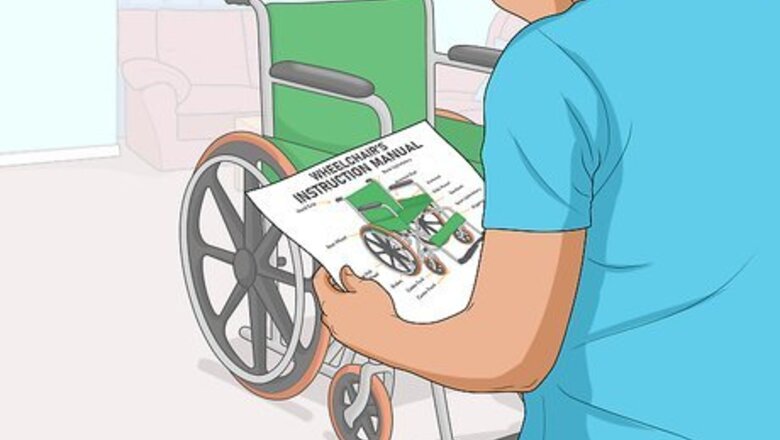
views
Know Your Wheelchairs
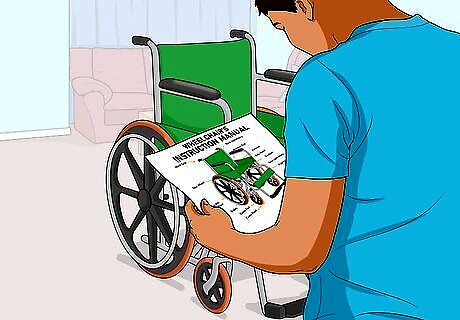
Take a look at your wheelchair to see what type you have. The main types of wheelchair are the standard manual wheelchair, the active manual wheelchair, and the electric power wheelchair. Different types of wheelchairs have different controls, structure and accessories to help you move around. Manual wheelchairs require you to propel by pushing the pushrims by hand. Standard wheelchairs often have features such as armrests (fixed, removable or swing-away), swing-away or removable footplates, and attendant handles on the back of the armrest. Some standard chairs can fold for transport, others are rigid and can’t collapse. Active wheelchairs are designed for longer-term and more fluid use. They typically do not have armrests, have lower backrests, and often lack attendant handles. Active chairs are often rigid but folding varieties exist. Electric wheelchairs include motors and remote controls that you use to direct and move the chair with less physical exertion, for those who cannot propel a manual chair. Manual chairs may be equipped with power assist, typically bought separately, to allow you to move forward without constant propelling. A fourth type of wheelchair is the transit chair, which you cannot move yourself and must be pushed by a friend, family member or carer. These are designed for people who cannot propel themselves. If you’re buying a chair online, be sure you are buying a self-propelled chair and not a transit chair. This can be an expensive mistake!
Wheelchairs are always equipped with brakes (also called wheel locks) located beside the main wheels. These lock into place to stop your chair from moving. These can be used when you are stopped at a destination or transferring in or out of your wheelchair. Some standard chairs will have attendant brakes on the attendant handles, which can be used by a friend, family member or carer to brake the chair from behind.
Check Your Fit
The structure and measurements of a wheelchair varies, and having the right fit for your body and needs is very important to make sure you are comfortable and supported. The size and arrangement of the seat, backrest, footplate and other features will determine your comfort and ability to use the chair.
Check that the size of the wheels suits. This impacts the overall height of the chair as well as how it moves. Wheels are usually measured in inches and can come in a variety of sizes. While you can sometimes swap these later, this can take experience and be hard and expensive.
Explore your seat. Your seat should be comfortable and about as wide as your hips. The width of the seat is important. If it’s too wide, you will need to reach outwards to reach your pushrims, which can cause strain, tiredness and injury. If it’s too narrow, you won’t be able to fit or use the chair comfortably, or even at all. The height of your seat is important. Your hips should be elevated slightly above your knees. A good way to check is to see if two fingers fit beside the widest point of your hips/thighs and the edge of the seat. The depth of the seat is important too. Your knees should be able to be at a 90 degree angle. Some standard chairs have differently angled leg rests. If you’re using the chair for long periods of time, consider a wheelchair cushion to protect and support your hips, lower back and tailbone.
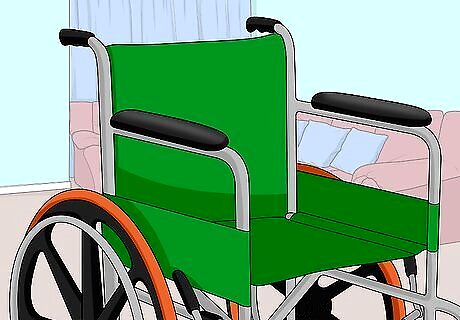
Check your backrest. Before using the wheelchair, you want to make sure it will be the most comfortable for you. Wheelchairs usually come with cushions on the seat and backrest, but you might need to change some settings to get more comfortable, like adding cushions to push you up or a blanket to cover a cold seat.The height and fit of your backrest will impact your comfort and how easily you can push your wheelchair. Ideally your backrest will leave clear space behind your shoulders so that you can easily propel your wheelchair. Standard chairs usually have high backrests, but many can be folded down for transport. Folding these down during use can give you the clear space needed for propelling your chair. Active chairs usually have low backrests shaped to support you best. They may or may not have handles. Some wheelchairs will have high backs and headrests for those that need extra support of the upper body and head. If you have trouble sitting completely upright, find more pillows to add to the seat or the backrest so you can sit in a position that will let you reach the controls you need.
Manage your handles. If your wheelchair has attendant handles on the back, these can be both helpful and harmful. They’re great if you tire easily and need a friend, family member or carer to begin pushing you, but can have drawbacks. Some handles have attendant brakes, so if you need to be pushed, the person helping you can have control over the chair without needing to reach forward. Handles can be a great place to hang a bag from. Be sure to distribute weight evenly between left and right, and don’t put too much on the back of your chair. If it’s too heavy, you might tip over backwards, which can cause serious injury. Unfortunately, well-meaning but uninformed strangers may try to push you against your will. If your attendant handles can be folded down, or if your standard chair has a folding back, this can hide the handles from view and help prevent this. If your handles cannot fold away and people try to push you, consider handle covers.
Measure your footplate. The distance between the edge of the seat and the top of the footplate can make a big difference in the fit of your wheelchair, and if it’s too short or too long can make the chair painful to use. Your feet should sit comfortably on the footplate with your knees at a 90 degree angle. If your knees are pushed above your hips, the footplate is too high. If your feet can’t reach, it’s too low. To change the height of your footplate, use a wrench or hex key (one is usually provided with the chair) to loosen the front bolts. Then rotate the footplates to adjust the height to the desired level. Use the wrench to tighten the bolts when you’ve finished adjusting. Standard chairs may have swing-away footplates that swing to the sides. These can assist you with transferring in and out of your wheelchair. If you need extra height, a thick wheelchair cushion can give you a boost. Make sure to check the height while wearing your usual choice of shoes. The thickness of the sole can make a difference.
Understand your chair’s structure and add-ons. The basic features and added pieces on your wheelchair can make a difference in how you can use it. Wheelchairs may feature different types of casters (front wheels), armrests, anti-tippers or phone/drink holders. The size of your caster decides what your chair is good at. Small casters let you move faster, but you’ll struggle more over rough terrain like grass, cobblestone, rocks and cracked roads. Large casters give you a smoother ride over rough terrain but you can’t move as fast. Armrests can be comfortable when you aren’t moving, but they can make it hard to propel. Active wheelchairs usually don’t have these. On a standard chair, swing-away or removable armrests are best. If you do have armrests, make sure you can propel without having to reach out too far, and that you aren’t hitting the armrest with your arm as you move. Anti-tippers are optional on many wheelchairs. They are tiny wheels on the back of the chair that help stop you falling backwards when on steep slopes, or if there’s weight on the back of your chair. Wheelchairs can be equipped with bags or holders for items like your phone and keys, or to hold a drink for you while you move. For some injuries, an extended leg rest may be used to keep your leg straight. This can make turning and fitting in elevators hard, so you'll need to be aware of your body.
Sitting in the Wheelchair
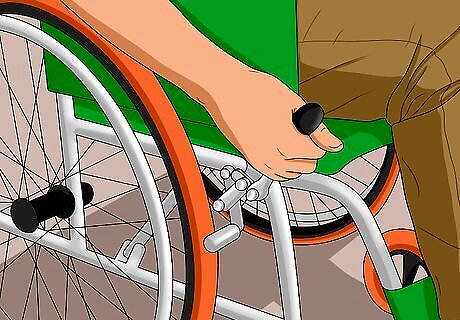
Before you start moving around, you’ll want to get into your chair. First, make sure your brakes are on by checking the sides of your wheels or pressing the pedal brake. This will ensure that your chair stays still while you get in it.
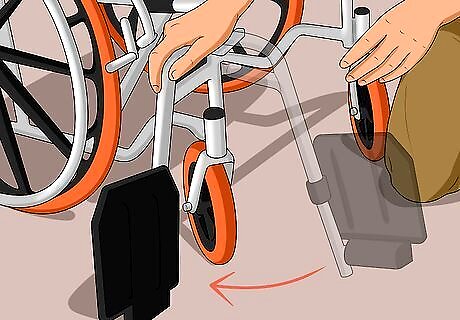
If your wheelchair has swing-away footplates, move these to the side. This makes it easier to sit down if you have low mobility or may trip.
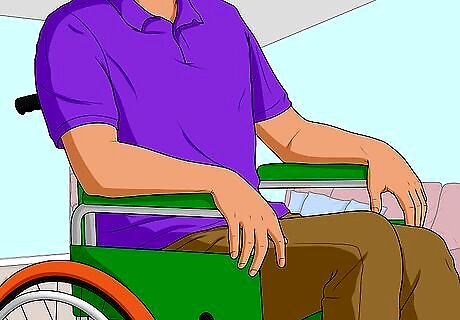
If you are unsteady, use a stable object or transfer rail to support you. If your wheelchair has armrests, these can be used. You are going to lower yourself into a sitting position in the wheelchair, so you will want your back to face the chair. Then, as you can, lower yourself onto the seat.
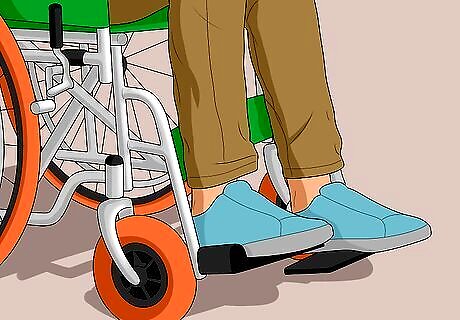
If you moved your footplates, you will want to move them back so you can rest your feet on them.
Moving Forward and Backward
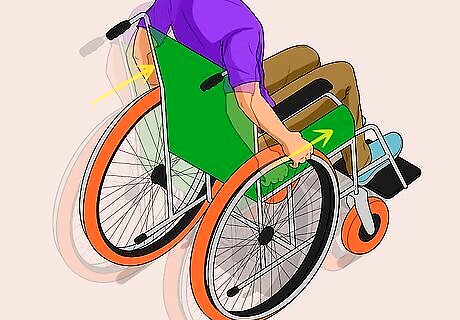
Once you’re comfortably seated, get ready to start moving! On each wheel of the chair there will be pushrims you use to move. To move forward, grip each pushrim just behind you and push forwards evenly with each hand. Let go and return your hands to the starting position, then repeat. There are different techniques to make propelling easier. A good way to do this is to push forward and, when letting go, move your hands in an arc to return to the starting position. Moving in a smooth circular motion will help you move more easily than just moving your hands back and forth, and will be less tiring. Electric wheelchairs have different types of controls to move you forward. These controls can either be a mini joystick that you push forward; a touchpad upon which you place your fingers then drag them forward, away from you; or a switch, which you flip on to move forward. Remember to tuck your elbows in when you move through doorways and narrow aisles.
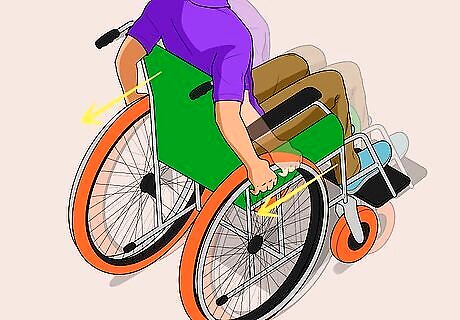
To go backwards, grip the front of the pushrims and pull back towards yourself. Let go and return your hands to the starting position, then repeat.
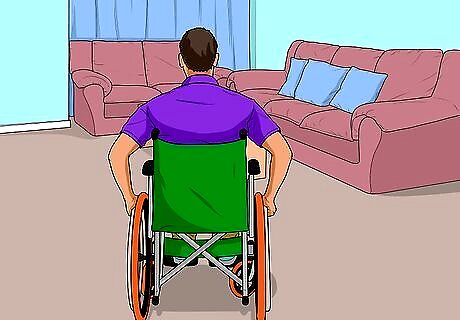
Practice at home to get comfortable and confident with the movement of you and your chair. Getting used to the actions will make it easier to move around outside. When you’re on a slope, be cautious. If possible, have a friend, family member or carer ready to catch you if you tip or lose control while you’re getting used to your wheelchair. It can be difficult to control the speed gained going downhill, and it is difficult to push on an uphill slope. Be aware of the people around you when on slopes. Most people won’t realise to get out of the way! If you’re on a downhill slope you will pick up speed very quickly, and may collide with others. Having clear space ahead as you approach an uphill slope will let you pick up speed, making it easier.
Making Right and Left Turns

To turn right, pull your right wheel back and push your left wheel forward at the same time. On an electric chair, turn your joystick to the right, drag your fingers to the right on your touchpad, or flip your right switch on.
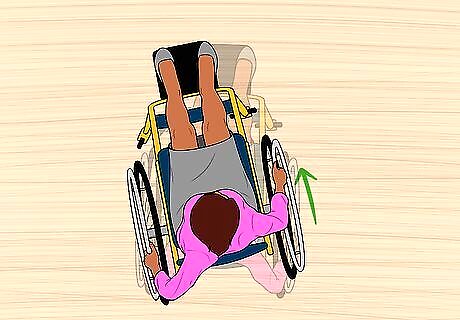
To turn left, pull your left wheel back and push your right wheel forward at the same time. On an electric chair, turn your joystick to the left, drag your fingers to the left on your touchpad, or flip your left switch on.
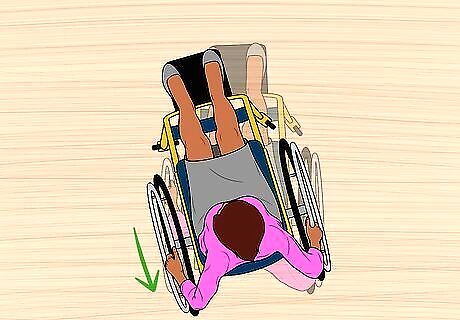
To move backward and to the right, push your right wheel and pull the left wheel backward.
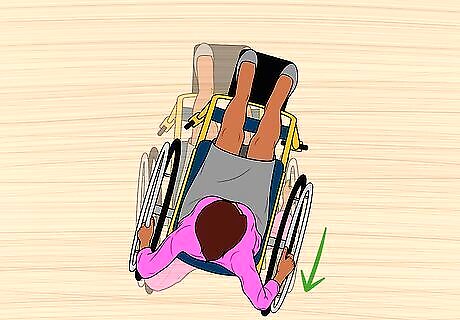
To move backward and to the left, push your left wheel and pull the right wheel backward.
Getting out of the Wheelchair
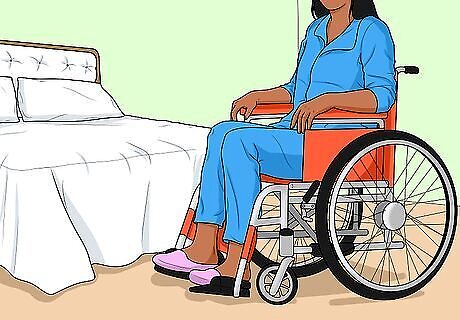
If you are transferring between your wheelchair and your bed, a toilet or a seat, move close to your destination.
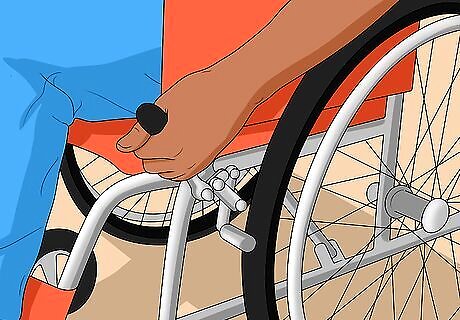
Turn your brakes on. Like when you get into a wheelchair, when you get out you want it to be still. So turn your brake levers back into position to stop your wheels from moving.
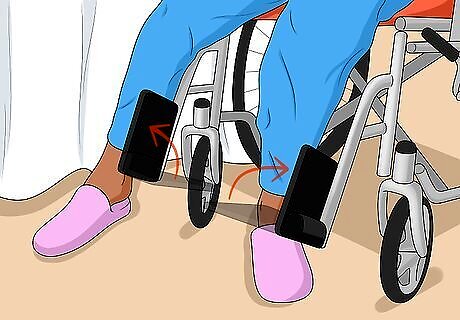
If your wheelchair has swing-away footplates, move these to the side and rest your feet on the floor.
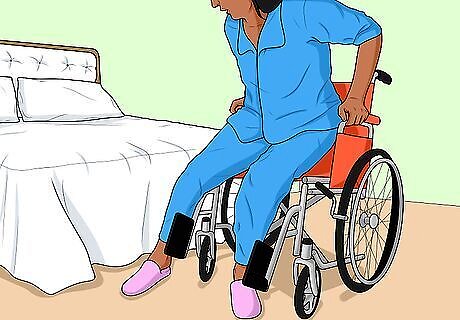
If you are unsteady, use a stable object or transfer rail to support you. If your wheelchair has armrests, these can be used. When using armrests, put your hands on each armrest and lean forward to push up. If you need assistance with transferring, a friend, family member or carer may be able to help you. If you are able to stand confidently, be sure to not trip over the footplates when exiting your chair.
Safety and Confident Moving
If you can, it's always best to consult a doctor and/or occupational therapist about wheelchair use. Different countries have different ways of organising this, but especially if your disability or injury will need you to use a wheelchair for a longer time having a doctor's input is important. Wheelchairs are best understood as a mobility replacement more than a mobility aid. If you're needing it for long term use, you'll need your doctor to help work on managing your disability or injury. In some countries you can recieve funding assistance from insurance or the government to fund a wheelchair if you go to your doctor.
Of course it’s best to avoid falling, but it’s a good idea to be prepared just in case. Falls can occur because of obstacles on the ground, too much weight on the back of the chair, collisions, or losing control of the chair. Know the brace position that best suits your body and chair. Typically this is putting your face to your knees and crossing your arms in front of you as you fall. Protecting your head, back and arms when you fall is most important as these are how you get around. Practise righting yourself and your chair at home. This is easier with the help of another person to catch you while you work out your movements and the weight and movement of your chair.
If you have limited or no sensation in your legs or feet, be careful to avoid collisions, even with small objects. It can be dangerous if you injure your foot or leg because you may not notice until you leave your chair.
City and town environments can be hazardous. Even places that are “wheelchair accessible” will have obstacles and hazards that make it difficult or risky to move. Stairs aren’t the only problem! Be careful when you come across a new type of ground. Uneven concrete, cobblestones, grass, dirt, tactile paving, rail lines and other obstacles can snag your casters or tip you out. Be aware of footpaths that slant towards the road. You may need to propel with only one arm or propel very slowly to avoid sliding into the street. When crossing the street, be very careful. You’re now below the eye-line of most drivers and they may not see you if they’re not paying attention. If you go out a lot at night, consider bicycle reflectors on your wheels to help protect yourself.




















Comments
0 comment